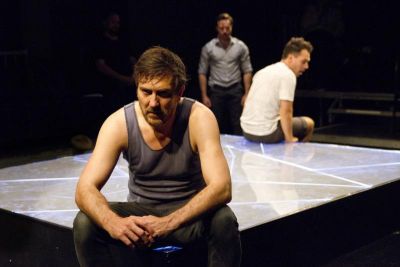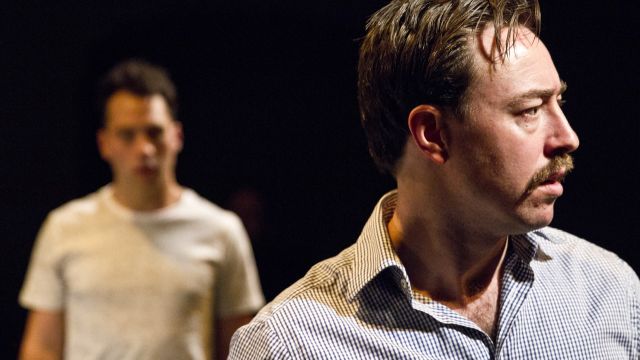Rust and Bone
The rust is the taste of your own blood in your mouth. The bones are what get broken, smashed and crushed. This is a play about fighting, about male aggression and violence. About being robbed of power. Caleb Lewis has taken stories by Craig Davidson of three men – a boxer, a fighting dog breeder/trainer, and an Orca trainer at Sea World - and woven them together into a sort of contrapuntal aural montage so that the three stories and the three men who tell them bounce off each other, illuminating, contrasting and yet revealing what they have in common.
The contrapuntal weaving of different voices telling different but thematically linked stories is a risky enterprise (c.f. Red Stitch’s recent Sunshine) and not often to my taste. I’d rather see characters interact than be narrated at; I’d rather ‘show’ than ‘tell’. But Rust and Bone works – works because of the emotion and the imagery of the writing and because of its precision, its energy, the performances and the way Mr Lewis makes the stories work together although his three characters – his three storytellers – never meet.
 The three strands are part monologue, part interactions. When an interaction is part of one man’s story, another of the cast transforms instantly to another character – in posture, voice and attitude – to fulfil that role. At first this can be a shock and, well, funny – for instance to see a tall, rough head bloke play a Mum. But it is so well done, by all three men, that you attend to the scene and not how it’s delivered. Ingrid Voorendt directs – choreographs - movement on and around the central platform stage (the audience is on all four sides) – and those movements are crisp, coordinated and almost frightening in the actors’ attack. It’s one knockout blow after another, one winded, injured, humiliated man after another.
The three strands are part monologue, part interactions. When an interaction is part of one man’s story, another of the cast transforms instantly to another character – in posture, voice and attitude – to fulfil that role. At first this can be a shock and, well, funny – for instance to see a tall, rough head bloke play a Mum. But it is so well done, by all three men, that you attend to the scene and not how it’s delivered. Ingrid Voorendt directs – choreographs - movement on and around the central platform stage (the audience is on all four sides) – and those movements are crisp, coordinated and almost frightening in the actors’ attack. It’s one knockout blow after another, one winded, injured, humiliated man after another.
As you might infer, it takes three excellent actors and a director with a clear and detailed vision to make this work. Rust and Bone has these people. Daniel Clarke gives us something challenging but coherent and highly disciplined. And if it’s a depiction of flawed masculinity, we get three variations, three versions of masculinity.
 Glen Maynard is ‘Eddie’ the boxer: tall, rangy, powerful, maybe the most violent of the three, maybe because violence is all he has, and therefore the saddest of the three. His story resolves in loss… because he lets down his guard. Luke Mulquiney is James, a man with fertility problems. If he can’t fight, his dog will fight for him. Mr Mulquiney suggests so very clearly a man who lives vicariously but desperately, investing his whole being in a stubborn hope of victory that we know is a delusion. So too is James’ story one of loss. Adam Ibrahim is Ben – strutting, cocky, sexist, oozing testosterone (Mr Ibrahim’s dance training is there in his suggestive, contained movements), until Nature – so to speak – strikes back, taking revenge, effecting a symbolic castration. All three tough guys, all three on guard behind facades.
Glen Maynard is ‘Eddie’ the boxer: tall, rangy, powerful, maybe the most violent of the three, maybe because violence is all he has, and therefore the saddest of the three. His story resolves in loss… because he lets down his guard. Luke Mulquiney is James, a man with fertility problems. If he can’t fight, his dog will fight for him. Mr Mulquiney suggests so very clearly a man who lives vicariously but desperately, investing his whole being in a stubborn hope of victory that we know is a delusion. So too is James’ story one of loss. Adam Ibrahim is Ben – strutting, cocky, sexist, oozing testosterone (Mr Ibrahim’s dance training is there in his suggestive, contained movements), until Nature – so to speak – strikes back, taking revenge, effecting a symbolic castration. All three tough guys, all three on guard behind facades.
Chris Wenn’s sound runs all the way through, but it’s unobtrusive, undistracting and genuinely supports the drama. Likewise Richard Vabre’s lighting. This is relentless, visceral theatre without much breathing space. The focus the three cast bring to their main roles - and their supporting roles - is truly impressive. If at the end you feel a little wrung out, it’s because you’ve been held and moved and had secrets revealed.
Michael Brindley
Photographer: Daisy Noyes.
(By the way, Caleb Lewis’ source material, that is, Craig Davidson’s 2007 stories, was also the basis for the 2012 French movie Rust and Bone (De rouille et d’os), but director Jacques Audiard and screenwriter Thomas Bidegain made more radical changes: in both play and movie, an Orca trainer at a ‘Sea World’ attraction loses a leg; in the movie, it’s both legs and the trainer is a woman (Marion Cottillard). Both play and movie feature boxing, but in the movie, it’s bare knuckle street fighting – and the disabled woman falls in love with the street fighter.)
Subscribe to our E-Newsletter, buy our latest print edition or find a Performing Arts book at Book Nook.

